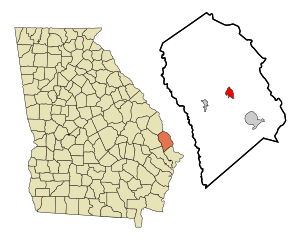Springfield, Georgia facts for kids
Quick facts for kids
Springfield, Georgia
|
|
|---|---|
| Motto(s):
"Where What's Close to Your Heart Still Matters"
|
|

Location in Effingham County and the state of Georgia
|
|
| Country | United States |
| State | Georgia |
| County | Effingham |
| Area | |
| • Total | 3.25 sq mi (8.41 km2) |
| • Land | 3.25 sq mi (8.41 km2) |
| • Water | 0.00 sq mi (0.00 km2) |
| Elevation | 79 ft (24 m) |
| Population
(2020)
|
|
| • Total | 2,703 |
| • Density | 831.95/sq mi (321.22/km2) |
| Time zone | UTC-5 (EST) |
| • Summer (DST) | UTC-4 (EDT) |
| ZIP Code |
31329
|
| Area code(s) | 912 |
| FIPS code | 13-72780 |
| GNIS feature ID | 0333107 |
| Website | City of Springfield Georgia |
Springfield is a city located in Effingham County, Georgia, in the United States. In 2020, about 2,703 people lived there. Springfield is the main city, or county seat, of Effingham County. It is also part of the larger Savannah area, which includes Savannah and its nearby towns.
Contents
History of Springfield, Georgia
Springfield was started in 1799. It probably got its name from a large farm or "plantation" that was in the area. The government of Georgia, called the Georgia General Assembly, officially made Springfield a city in 1838. This means it became a recognized town with its own local government.
Geography and Location of Springfield
Springfield is located in the middle of Effingham County. Its exact coordinates are 32.368240 degrees North and -81.310152 degrees West.
How to Get to Springfield
Two main roads pass near Springfield. Georgia State Route 21 goes around the west side of the city. Route 119 passes closer to the center of town.
Distances to Nearby Cities
- If you travel south on GA 21, it's about 26 miles (42 km) to Savannah.
- Going northwest, it's about 33 miles (53 km) to Sylvania.
- Route 119 leads southwest about 5 miles (8 km) to Guyton.
- If you go north on Route 119, it's about 12 miles (19 km) to the border of South Carolina.
Land Area of Springfield
The United States Census Bureau says that Springfield covers a total area of about 7.1 square kilometers (2.7 square miles). All of this area is land, with no water.
Population and Demographics of Springfield
The population of Springfield has changed over the years. Here's a look at how many people have lived there during different census counts:
| Historical population | |||
|---|---|---|---|
| Census | Pop. | %± | |
| 1870 | 32 | — | |
| 1910 | 504 | — | |
| 1920 | 377 | −25.2% | |
| 1930 | 402 | 6.6% | |
| 1940 | 458 | 13.9% | |
| 1950 | 627 | 36.9% | |
| 1960 | 858 | 36.8% | |
| 1970 | 1,001 | 16.7% | |
| 1980 | 1,075 | 7.4% | |
| 1990 | 1,415 | 31.6% | |
| 2000 | 1,821 | 28.7% | |
| 2010 | 2,852 | 56.6% | |
| 2020 | 2,703 | −5.2% | |
| 2023 (est.) | 3,284 | 15.1% | |
| U.S. Decennial Census | |||
Diversity in Springfield
The table below shows the different groups of people living in Springfield as of the 2020 census. This helps us understand the city's diversity.
| Race | Num. | Perc. |
|---|---|---|
| White (non-Hispanic) | 1,833 | 67.81% |
| Black or African American (non-Hispanic) | 607 | 22.46% |
| Native American | 7 | 0.26% |
| Asian | 11 | 0.41% |
| Pacific Islander | 3 | 0.11% |
| Other/Mixed | 114 | 4.22% |
| Hispanic or Latino | 128 | 4.74% |
In 2020, there were 2,703 people living in Springfield. These people made up 1,392 households, and 857 of these were families.
Education in Springfield
Springfield is part of the Effingham County School District. This district provides education for students from pre-school all the way through twelfth grade.
Schools in Effingham County
The Effingham County School District has many schools to serve its students.
- It has eight elementary schools for younger children.
- There are three middle schools for students in the middle grades.
- The district also has two high schools for older students.
School District Facts
The district employs 511 full-time teachers. More than 9,037 students attend schools within the Effingham County School District.
Elementary Schools
- Blandford Elementary School
- Ebenezer Elementary School
- Guyton Elementary School
- Marlow Elementary School
- Rincon Elementary School
- Sand Hill Elementary School
- South Effingham Elementary School
- Springfield Elementary School
Middle Schools
- Ebenezer Middle School
- Effingham County Middle School
- South Effingham Middle School
High Schools
- Effingham County High School
- South Effingham High School
Notable People from Springfield
Many interesting people have come from Springfield. Here are a few who have become well-known:
- Paul Carrington - a professional football player.
- JaKeenan Gant (born 1996) - a basketball player who plays for Hapoel Be'er Sheva in the Israeli Basketball Premier League.
- Josh Reddick - a professional baseball player.
- Charlton W. Tebeau - a historian, someone who studies and writes about the past.
- Artie Ulmer - a professional football player.
- Dusty Zeigler - a professional football player.
See also
 In Spanish: Springfield (Georgia) para niños
In Spanish: Springfield (Georgia) para niños

